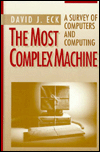Difference between revisions of "CSC103 Syllabus 2011"
(→Teaching Assistants) |
(→Tentative list of topics covered) |
||
| Line 49: | Line 49: | ||
*Binary system, arithmetic, logic gates (Chaps 1, 2) | *Binary system, arithmetic, logic gates (Chaps 1, 2) | ||
| − | *logic gates, binary adder (Chap 2) | + | * Truth tables |
| + | * logic gates, binary adder (Chap 2) | ||
* Building a computer (Chap 5) | * Building a computer (Chap 5) | ||
| + | * Taking apart a computer | ||
| + | * Creating a [http://en.wikipedia.org/wiki/Wiki Wiki] page | ||
**von Neuman architecture | **von Neuman architecture | ||
**Von Neuman bottleneck | **Von Neuman bottleneck | ||
** CPU, RAM, Secondary Memory | ** CPU, RAM, Secondary Memory | ||
| − | |||
* History of computers (Chap 5) | * History of computers (Chap 5) | ||
* Programming: Javascript (Chap 6) | * Programming: Javascript (Chap 6) | ||
Revision as of 17:20, 23 January 2011
--D. Thiebaut 09:07, 7 January 2011 (EST)
<meta name="keywords" content="computer science, how computers work, introductory" /> <meta name="description" content="Dominique Thiebaut's Web Page" /> <meta name="title" content="Dominique Thiebaut -- Computer Science" /> <meta name="abstract" content="Dominique Thiebaut's Computer Science Web pages" /> <meta name="author" content="thiebaut at cs.smith.edu" /> <meta name="distribution" content="Global" /> <meta name="revisit-after" content="10 days" /> <meta name="copyright" content="(c) D. Thiebaut 2000, 2001, 2002, 2003, 2004, 2005, 2006, 2007,2008" /> <meta name="robots" content="FOLLOW,INDEX" />
Contents
CSC 103: How Computers Work, Spring 2011
Overview
This course has no prerequisites. It is intended to introduce students to the history, theory and use of digital computers. Students from all majors are welcome - though there is some math and computer programming during the semester, the course is designed assuming students have no previous computer experience. Through the material presented in this course, students will be introduced to:
- A brief history of computers
- Binary numbers, and understanding how and why computers use them
- Logic gates - the basic building blocks of computers
- Javascript programming - which you may find you'll like to use beyond this course!
- A better understanding of how the computer does everything you direct it to do.
- Some important issues about computers in our future
A great number of topics are discussed in this seven week period, with the purpose not to explore any one topic fully or in depth. Rather the purpose is to provide a high level view of how a computer works - from the most fundamental hardware component (the logic gate) through the sophisticated programs we all use every day (such as word processors). Hopefully this first look at all these topics will encourage students to take additional courses in areas that are of most interest.
Instructor
Dominique Thiebaut
Office: Ford Hall 356
Email: thiebaut@cs.smith.edu
Office Hours: TBA
Schedule
First half of Spring 2011, Jan 24 to March 11.
Textbook
The Most Complex Machine., by David Eck, A. K. Peters, Natick Ma [1]. This book should be available at the Greycourt bookstore. ( List of Chapters)
Tentative list of topics covered
- Binary system, arithmetic, logic gates (Chaps 1, 2)
- Truth tables
- logic gates, binary adder (Chap 2)
- Building a computer (Chap 5)
- Taking apart a computer
- Creating a Wiki page
- von Neuman architecture
- Von Neuman bottleneck
- CPU, RAM, Secondary Memory
- History of computers (Chap 5)
- Programming: Javascript (Chap 6)
- Programming Environment (Chap 7)
- Program development
- Other programming languages
- Parallel Programming (Chap 10)
- Folding @ home
- SETI
- The Singularity:
- Signs of the Singularity by Vernor Vinge.
- Can Machine Be Conscious?, Christof Koch and Giulio Tononi.
Grading
- Attendance and participation: 10%
- Homework assignments (roughly one weekly assignmnent): 50%
- Quizzes: 10%
- Final take-home exam: 30%
No late assigments will be accepted.
Teaching Assistants
|
|
|
| |
|
|
